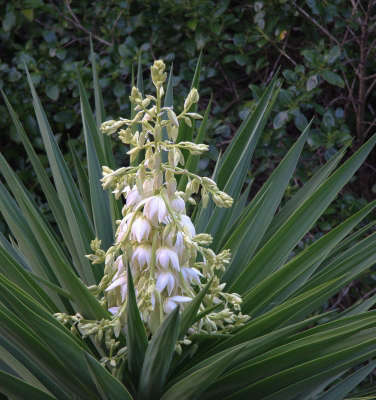

Yuccas are handsome desert shrubs with unusually thin, swordlike foliage for a succulent, making them a useful specimen plant in a layered, textured garden bed. Give them full sun and well-drained soil, and yuccas will be happy in a hot climate even if temperatures top 100 degrees Fahrenheit.
Yuccas often get confused with agaves, because both are succulent shrubs that grow in clumps in the desert (and in dry gardens in warm climates) and both send up occasional spikes of flowers. Here’s how to tell the difference:
Yuccas have long, thin leaves that look like knife blades (as opposed to agave’s plumper, swollen leaves) and some varieties—such as Joshua trees—have trunks that make them look more like trees than shrubs. While agaves bloom once in a lifetime, yuccas can flower repeatedly over the course of several seasons.
Yuccas are useful to add stature and drama in a xeriscape, requiring little water and no maintenance beyond a sunny spot and well-drained soil. With more than 50 different species, yuccas will thrive in a wide range of climates, from USDA growing zone 4 (where Yucca filamentosa ‘Bright Edge’ is a perennial) to zone 11 (where Y. gloriosa var. recurvifolia will brave the heat with its theatrical spikes of creamy white flowers).
Tip: Plant yuccas well away from walkways so pedestrians can avoid their sharp, swordlike foliage.
v5.0
When you register as a free Member of the Remodelista family of websites (Remodelista, Gardenista, and The Organized Home), you gain access to all current posts plus 10 archived posts per month, our internal bookmarking tool, and the community bulletin board.
Member benefits include:
For $5/month ($59.99 paid annually) you'll enjoy unlimited, ad-free access to Remodelista, Gardenista, and The Organized Home and all the benefits of Membership.
Subscriber benefits include:
For $5/month ($59.99 paid annually) you'll enjoy unlimited, ad-free access to Remodelista, Gardenista, and The Organized Home and all the benefits of Membership.
Subscriber benefits include:
Benefits include:
For $5/month ($59.99 paid annually) you'll enjoy unlimited, ad-free access to Remodelista, Gardenista, and The Organized Home and all the benefits of Membership.
Subscriber benefits include:
When you register as a free Member of the Remodelista family of websites (Remodelista, Gardenista, and The Organized Home), you gain access to all current posts plus 10 archived posts per month, our internal bookmarking tool, and the community bulletin board.
Member benefits include:
If at any time you want to become a Subscriber and enjoy unlimited, ad-free access to all our content, just go to the My Account link and choose Subscribe.
Advertising funds our work at Gardenista and helps us provide you with a daily dose of garden inspiration & design. We hope you’ll consider disabling your adblocker for Gardenista so we can continue our mission: a well-designed garden for all.
Thank you for your support.